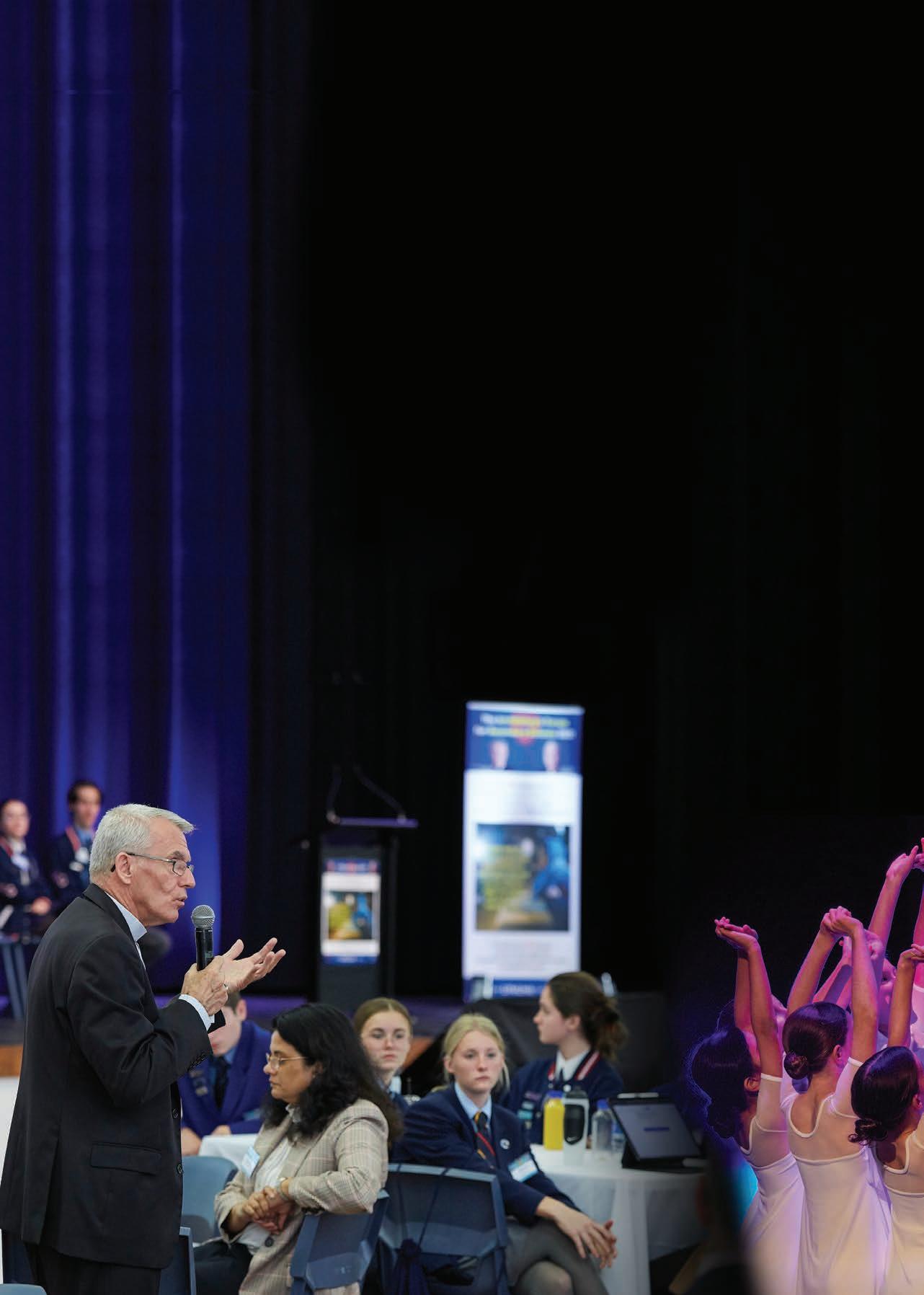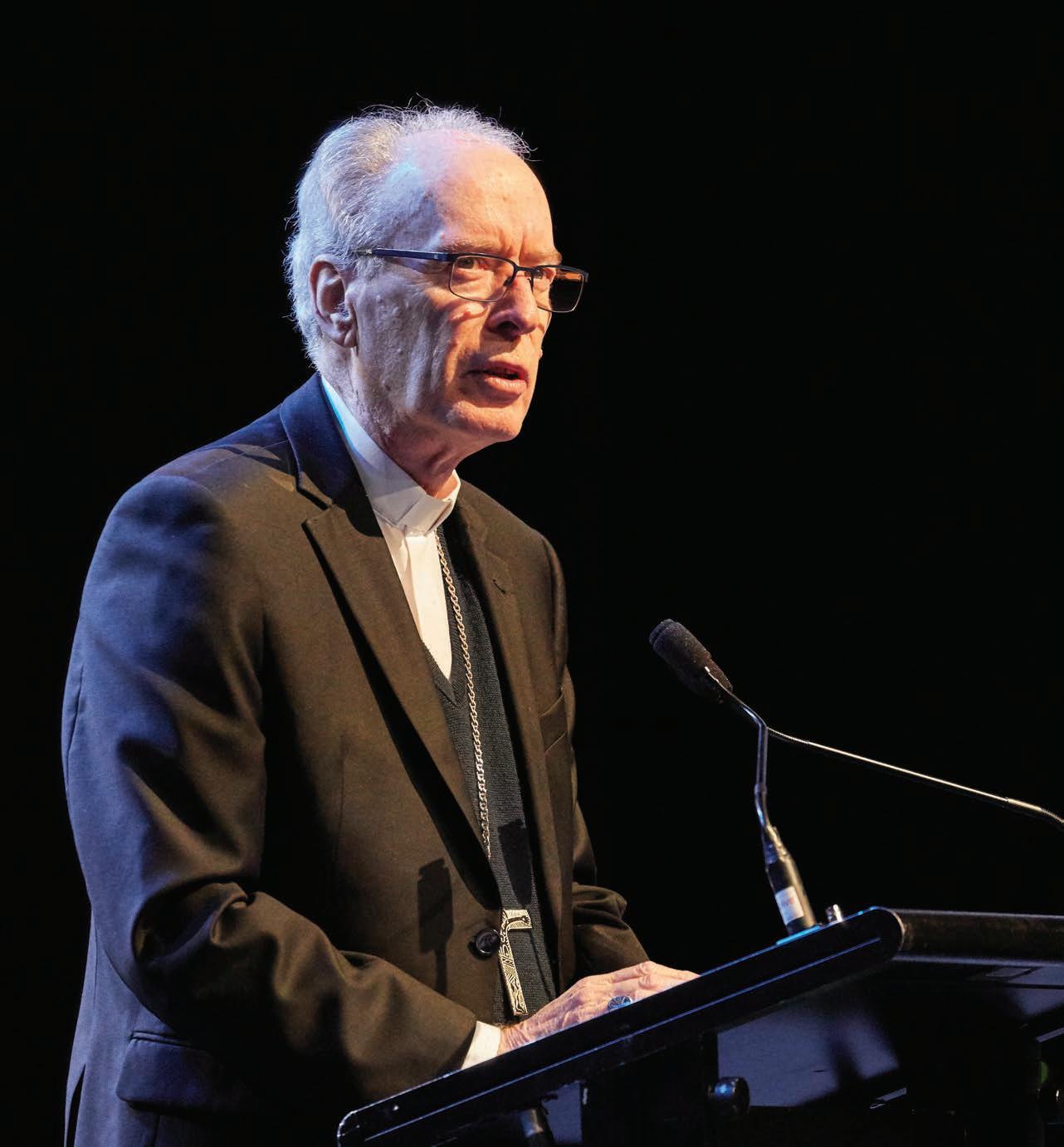
13 minute read
Jurien Bay Church Dedication
“BE A COMMUNITY OF CHRIST,” ARCHBISHOP COSTELLOE ENCOURAGED ALL AT THE DEDICATION OF NEW JURIEN BAY PARISH
WORDS Jamie O'Brien
The new Church of Our Lady Star of the Sea Jurien Bay, blessed and dedicated by Perth Archbishop Timothy Costelloe SDB on Saturday, 29 May, was the result of more than 50 years of prayers and waiting, said Moora Parish Administrator, Fr Renald Anthony. “For those who do not know the story behind how many years the people have been praying and waiting for, I was told that it was as early as Msgr Cameron’s time, which was at least 50 years ago, when he dreamt of having a church in this region, here in Jurien Bay Cervantes,” Fr Anthony said. “This is not all possible today, without the prayers and blessings of all the people that worked for this over the last 50 years.” Joining Archbishop Costelloe to concelebrate the Mass was Fr Anthony, former Parish Priest and now York Parish Priest-in-Charge Fr Chris Webb, Fr Peter Bianchini as MC, Redemptoris Mater Seminary Vice-Rector, Fr Luis Tijerino, as well as several priests from across the Archdiocese of Perth who travelled the two-and-a-half-hour journey for the special occasion. In his homily, Archbishop Costelloe reflected on the readings of the day, highlighting three main points of what it means to be the Church of God, drawing on the writings from Vatican II and specifically Lumen Gentium. “I wanted to take this opportunity just to reflect briefly with you on what it means to say, as Paul does in the second reading this morning, that we are both building and being built into a spiritual house for God, which is built on the prophets and the apostles and which has Christ himself as the cornerstone,” Archbishop Costelloe began. “We, you here, who come to this parish, you are like a sacrament. This is your vocation. “What does that mean? To be a sign and an instrument, a means through which God brings people into communion with Him and into unity amongst themselves,” he added.
Archbishop Costelloe went on to explain that all who attend a parish, are considered a Sacrament, as each person’s faith journey is a ‘vocation.’ “What does that mean? To be a sign and an instrument, a means through which God brings people into communion with Him and into unity amongst themselves.” Archbishop Costelloe’s next point drew on a familiar expression of St John Paul II who said, ‘the Church is the community of the disciples of Jesus Christ’. “It’s a very simple idea: first of all, we’re a community, but we’re a community of disciples - which means we’re not following each other, we’re not gazing at each other - we’re following the Lord upon whom we gaze, and especially we do that when we gather here in this church,” Archbishop Costelloe emphasised. For his third point, Archbishop Costelloe looked to Pope Francis, who often refers to the Church as if it were a field hospital in the middle of a battle. “As Pope Francis said, ‘When a soldier is wounded, and is brought into the field hospital, the doctors and the nurses don’t begin by asking that soldier about his or her cholesterol levels or blood sugar level, or any of those sorts of things – they begin by healing the wounds,” he added. “The Holy Father went on to say that this is the great mission of the Church today, to heal people’s wounds. And then he added something more, he said not just to be a healer of people’s wounds, but a warmer of people’s hearts.” At the conclusion of Mass, the blessing of a special painting of Our Lady Star of the Sea by artist Bernadette Cartensen was carried out in the presence of more than 250 people who were in attendance. Jurien Bay Building Committee Chair John Willett, who spoke the Welcome and Acknowledgement to Country, acknowledged the Yued people, including elders, past, present and emerging. “From a Church perspective, the Church of Jurien Bay, which is the most northern of the Archdiocese of Perth, and from a Shire perspective, it’s the first new place of worship to be built on the turquoise coast,” Mr Willett said. “This achievement has been a long-held dream of many who are here today, several who are unable to be with us due to distance and health, and some who have passed to their eternal reward. “It is our hope that what our planning committee set out to achieve three years ago, commencing with Fr Chris Webb and under the Committee Chair of Wendy Harvey, is not only a fulfilment of that dream, but will become a place of worship for the whole community in Jurien Bay and Cervantes and our region; not simply for us but for the future,” Mr Willett concluded.

● LEFT Moora Parish Administrator Fr Renald Anthony speaks with a parishioner before the Dedication Mass on 29 May. Photo: Max Hoh. ● LEFT Parishioners with the artwork by artist Bernadette Cartensen. Photo: Max Hoh.
ARE YOU IN YOUR 40S OR OLDER? HERE’S WHY YOU SHOULD PAY ATTENTION TO YOUR SUPER

Your super is an investment for your retirement years and if you have many decades to go before you leave the workforce, it’s not surprising that paying attention to your retirement savings isn’t on your list of priorities.
However, if you’re in your 40s or older, there are some aspects of your super that may be worth keeping an eye on. Read on to find out why.
Super contributions and returns
Typically, the change in your super balance consists of two components: 1. Contributions that you and/or your employer makes 2. The return on your investment. In the early years of your work life, contributions make up a majority of the changes in your super balance. Given that the amount of super you have at this stage of your career tends to be small, negative returns resulting from volatile investment markets are not likely to have a material impact on your account balance at retirement.
As you get older and your account balance grows, the return on your investment can have a bigger impact on the change in your super. The hypothetical case studies below illustrate this impact.
Case study 1¹ 27-year-old Cindy has been a full-time teacher for two years and has been receiving 9.5 per cent super guarantee employer contributions on her $80,000 salary. After receiving these contributions and returns on her investments, Cindy’s account balance was $13,772 at the end of the second year.
During the third year, investment markets took a turn for the worse and Cindy received a return of -10 per cent. Feeling worried, Cindy checked her account

balance. She discovered that her investment losses of $1,693 were more than offset by her employer’s contributions of $6,987. This resulted in a closing balance of $19,033, a 38 per cent increase from her opening account balance at the start of the year.
As the investment markets had softened, Cindy benefitted investing subsequent contributions from her employer at lower prices, which could make a difference to her account balance in the future.
Case study 2¹ 46-year-old Samantha has been a full-time teacher since she was 25 and has not taken a career break since she began working. Like Cindy, Samantha has been receiving 9.5 per cent employer super guarantee contributions throughout her entire working life.
She now earns a salary of $109,365 and has a superannuation balance of $298,251. Samantha’s super hasn’t been impacted by major downturns in the investment markets to date. Pleased with her excellent returns, she leaves her super in the current investment options and doesn’t review how her retirement savings are invested.
Unexpectedly, investment markets fall by 10 per cent and Samantha finds that her superannuation account balance had fallen by $20,189. This is because her employer contributions of $10,144 were not enough to make up for her investment losses of $30,332.
The impact of contributions and investment returns on the change to your super balance
The graph above illustrates Cindy’s and Samantha’s experiences. Typically, investment returns start to have a bigger influence than contributions on the change to your account balance around your mid-40s¹. Consequently at this stage of your life, it becomes even more important that you review that your super is invested in options that align to your risk appetite and goals. Visit catholicsuper.com.au/investments/investmentbasics to find out more.
Impact on your super if you’re female
If you’re female, there are additional factors that may impact your super, including: • Women earn less on average than men. • Women are more likely to take a career break to care for their family. • Women live longer on average than men.
Visit catholicsuper.com.au/education/her-purse for tips on how you can get on top of your finances.
Any advice contained in this article is of a general nature only, and does not take into account your personal objectives, financial situation or needs. Prior to acting on any information in this article, you need to take into account your own financial circumstances, consider the Product Disclosure Statement for any product you are considering, and seek independent financial advice if you are unsure of what action to take.
¹Assumptions • A starting salary of $80,000 per year, which increases at 4.0 per cent per annum and is capped at $125,619 as per a Band 3 teacher under the Sydney Catholic Schools system. • Super Guarantee contributions were at a rate of 9.5 per cent. • No voluntary contributions are made. • An expected return of 4.5 per cent per annum (net of fees and charges) is assumed based on the return of Australian Catholic Superannuation’s Conservative Balance option and includes a 2 per cent rate of inflation. • Calculations include the 15 per cent super contribution tax.
These calculations are hypothetical. It does not take into account your personal objectives, financial situation or needs. As a result, you should consider its appropriateness to your own situation and obtain independent financial advice before making any decisions about your superannuation.
Plenary Council Agenda asks difficult questions


The Fifth Plenary Council of Australia agenda calls those attending the assemblies to “develop concrete proposals to create a more missionary, Christ-centred Church in Australia”. The Plenary plan, which has emerged from three years and several layers of prayer, listening, dialogue and discernment, will shape the programme of the Council’s assemblies – the first of which opens on 3 October 2021. The agenda’s preamble draws from Pope Francis’ Apostolic Exhortation Evangelii Gaudium, which explores the pontiff’s “dream of a ‘missionary option’.” “That is, a missionary impulse capable of transforming everything, so that the Church’s customs, ways of doing things, times and schedules, language and structures can be suitably channelled for the evangelisation of today’s world rather than for her self-preservation,” the Holy Father wrote. Plenary Council President Perth Archbishop Timothy Costelloe SDB said the invitation and exhortation to be a missionary people would run through the schedule. “Through the Plenary Council, we are being called to consider how we can be a Church that goes out to the peripheries, that welcomes all into our communities and shows the face of Christ to the world,” Archbishop Costelloe stated. The agenda has been developed to pose 16 questions falling under six themes: Conversion, Prayer, Formation, Structures, Governance, and Institutions. “So much of what we heard during the Council journey related to this concept of ‘conversion’ – personal conversion, communal conversion, and institutional conversion – with an ever-deeper renewal in Christ. “The agenda asks us several difficult questions, but without asking those difficult questions, we won’t be entering into the depth of our hearts to consider how we become that missionary, Christ-centred Church we need today. “Each member attending the assemblies will bring their own unique gifts to the agenda on behalf of the People of God in Australia.” Plenary Council Facilitator Lana Turvey-Collins said the agenda, published on the Plenary Council website, asks questions with widespread relevance. “These questions have been developed for a specific purpose – for prayer, conversation, discernment, and decision-making during the Plenary Council – but they are questions that can challenge each of us, each parish, each Church community,” she explained. “In preparing for the Council and beyond, the agenda can be a rich source of reflection and contemplation in our own settings.” Archbishop Costelloe asked people to continue to pray for the Council and its members who will attend the October 2021 assembly and subsequent July 2022 assembly. More than 280 members nationwide began participating in focussed formation sessions in June 2021.


Conversion • How might we better accompany one another on the journey of personal and communal conversion which mission in Australia requires? • How might we heal the wounds of abuse, coming to see through the eyes of those who have been abused? • How might the Church in Australia open in new ways to Indigenous ways of being Christian in spirituality, theology, liturgy, and missionary discipleship? How might we learn from the First Nations peoples? • How might the Church in Australia meet the needs of the most vulnerable, go to the peripheries, be missionary in places that may be overlooked or left behind in contemporary Australia? How might we partner with others (Christians, people of other faiths, neighbourhood community groups, government) to do this? • How might the Church in Australia respond to the call to ‘ecological conversion’? How can we express and promote a commitment to an ‘integral ecology of life’ in all its dimensions, with particular attention to the more vulnerable people and environments in our country and region?
Prayer • How might we become a more contemplative people, committing more deeply to prayer as a way of life, and celebrating the liturgy of the Church as an encounter with Christ who sends us out to “make disciples of all the nations”? • How might we better embrace the diverse liturgical traditions of the Churches which make up the Catholic Church and the cultural gifts of immigrant communities to enrich the spirituality and worship of the Church in Australia? Formation • How might we better form leaders for mission – adults, children and families, couples and single people? • How might we better equip ordained ministers to be enablers of missionary discipleship: the Church becoming more a “priestly people” served by the ordained ministry? • How might formation, both pre- and postordination, better foster the development of bishops, priests and deacons as enablers of the universal Christian vocation to holiness lived in missionary discipleship?
Structures • How might parishes better become local centres for the formation and animation of missionary disciples? • How might the Church in Australia be better structured for mission, considering the parish, the diocese, religious orders, the PJPs and new communities?
Governance • How might the People of God, lay and ordained, women and men, approach governance in the spirit of synodality and coresponsibility for more effective proclamation of the Gospel? • How might we recast governance at every level of the Church in Australia in a more missionary key?
Institutions • How might we better see the future of Catholic education (primary, secondary and tertiary) through a missionary lens? • How might we better see the future of Catholic social services, agencies and health and aged care ministries as key missionary and evangelising agencies?







